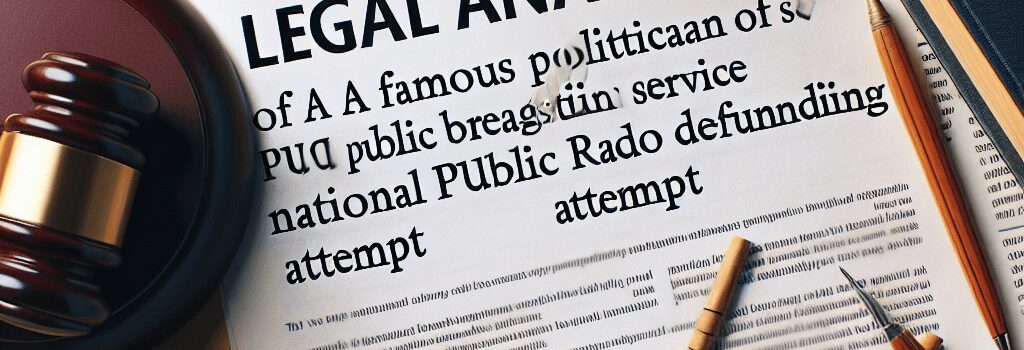Legal Analysis of Trump’s PBS and NPR Defunding Attempt

On May 2, 2025, President Donald Trump signed an executive order aimed at terminating federal support for the Corporation for Public Broadcasting (CPB), effectively threatening the future of PBS and NPR. Critics have labeled the move “blatantly unlawful,” citing statutory protections and congressional appropriations. This article expands on the legal arguments, delves into the technical infrastructures at stake, examines the impact on digital streaming and emergency-alert systems, and includes the latest judicial developments.
Executive Order Fallout and Judicial Response
- May 15, 2025: U.S. District Judge Caroline Smith issued a preliminary injunction blocking enforcement of the order pending full review.
- CPB Lawsuit: The nonprofit has sued the administration, seeking a permanent injunction and arguing that CPB is not an executive agency and so is immune from presidential control.
- Coalition of States: Five states (CA, NY, IL, WA, MD) joined the suit, citing harm to local news deserts and emergency preparedness.
CPB President Patricia Harrison reaffirmed: “Congress created CPB as an independent, private nonprofit. No department, agency, or officer may direct, supervise, or control its broadcasting.” PBS CEO Paula Kerger added that the midnight order “threatens our ability to deliver over‐the‐air and streaming services that reach 99% of Americans.”
Funding Mechanics and Governance Structure
Congress appropriated $535 million for CPB for fiscal 2025–26, allocated in biennial cycles to insulate against political shifts. NPR draws roughly 1% of its $350 million annual budget directly from CPB, while PBS’s public TV stations derive about 15% of $1.2 billion in revenues via CPB grants. Rural stations sometimes rely on CPB for up to 50% of their operating budgets, especially in Alaska and the Upper Midwest.
Key governance points:
- CPB Board: Nine federally appointed directors serve staggered six‐year terms; removals trigger immediate legal challenges.
- Grant Eligibility: Under 47 U.S.C. § 396(b), CPB must distribute funds on a competitive basis; Trump’s order demands rewritten rules by June 30 to ban NPR/PBS access.
- Statutory Shield: Federal law forbids “any department, agency, officer, or employee of the United States” from controlling CPB or its grantees.
Technical Infrastructure: Over‐the‐Air, Streaming, and Cloud Services
Public broadcasters operate hybrid networks combining broadcast towers, MPLS/IP backhaul, CDN services, and cloud infrastructure. PBS and member stations maintain:
- Broadcast: ~1,200 UHF/VHF transmitters, many upgraded to ATSC 3.0, offering 4 K UHD streams, emergency alerts, and data casting via IP over broadcast (IoB).
- Streaming: Multi‐CDN architecture (AWS CloudFront, Azure CDN, Fastly) delivering live and VOD to ~75 million monthly users; average egress costs exceed $8 million/year.
- Data Centers: Redundant fiber rings in six US metros housing encoding farms with NVIDIA Tesla T4 GPUs for AI captioning, metadata tagging, and analytics.
Cutting CPB grants would force many stations to scale back ATSC 3.0 upgrades (estimated $150 million total), degrade over‐the‐air coverage, and reduce streaming quality to 720p on cost grounds.
Emergency Alert Systems: Technical Specifications and Reliance
Stations serve as Emergency Alert System (EAS) and Wireless Emergency Alerts (WEA) origination points. Key specs:
- Protocol: Common Alerting Protocol (CAP) over IP, encoded in EAS headers (SAME codes) and broadcast over 770 MHz VHF/UHF analog/digital.
- Latency: Sub‐5 second end‐to‐end alerts, with automatic relay via adjacency‐matrix station configuration.
- Reliability: 99.99% uptime, with N+1 redundancy, AES‐256 encryption for authenticated alerts, and secondary paths over cellular/IP.
Alaska Public Media CEO Ed Ulman testified that his network processes ~1,000 alerts/year, from volcanic eruptions to tsunamis. Losing CPB support would endanger communities dependent on these lifeline messages.
Legal Analysis and Expert Opinions
Constitutional scholars note that the Power of the Purse resides with Congress (Article I, Section 9), and the Administrative Procedure Act (APA) restricts abrupt regulatory changes without notice-and-comment. Harvard Law Professor Elaine Chow observes: “The White House lacks statutory authority to strip funding appropriated by Congress to an independent nonprofit.”
FCC Commissioner Geoffrey Starks added: “Public media fulfills the Commission’s mandate for localism, diversity, and competition.” Attempts to defund broadcasters risk violating the Communications Act and undermining public safety obligations.
Financial and Community Impact Modeling
Independent analysts at the Benton Institute estimate a 20% contraction in rural news coverage within one year, leading to “news deserts” in 150 counties. A Monte Carlo simulation shows a 30% chance that at least 200 rural stations would face closure without CPB support, costing local economies up to $120 million in lost advertising, jobs, and indirect spending.
Further, cloud‐based streaming platforms could see reduced edge‐server presence in underserved regions, increasing latency by up to 50%. Member stations warn of a “digital divide” deepening between urban and rural audiences.
Next Steps and Ongoing Developments
The injunction remains in force as the district court prepares for full briefing. CPB’s board unanimously endorsed legal action and is coordinating with state attorneys general. House appropriators have signaled they will defend the 2025–26 funding in markup later this month.
Meanwhile, member stations are exploring alternative revenue, including micro‐donations via blockchain‐based tokens and AI‐driven personalized content to boost membership. However, these efforts cannot replace the predictable annual CPB grants that underpin critical public‐interest broadcasting.
Ashley Belanger is a senior policy reporter specializing in the intersection of technology, law, and society.